-
Tips for becoming a good boxer - November 6, 2020
-
7 expert tips for making your hens night a memorable one - November 6, 2020
-
5 reasons to host your Christmas party on a cruise boat - November 6, 2020
-
What to do when you’re charged with a crime - November 6, 2020
-
Should you get one or multiple dogs? Here’s all you need to know - November 3, 2020
-
A Guide: How to Build Your Very Own Magic Mirror - February 14, 2019
-
Our Top Inspirational Baseball Stars - November 24, 2018
-
Five Tech Tools That Will Help You Turn Your Blog into a Business - November 24, 2018
-
How to Indulge on Vacation without Expanding Your Waist - November 9, 2018
-
5 Strategies for Businesses to Appeal to Today’s Increasingly Mobile-Crazed Customers - November 9, 2018
IITs lose places in world rankings, MIT still on top
Nine out of 10 Indian Universities which have been ranked have come down on the list as compared to last year’s rankings.
Advertisement
Bengaluru, remained India’s highest-ranked institute this year.
The 2016-17 Quacquarelli Symonds World University Rankings has listed the Indian Institute of Science, Bangalore (IISc), and six other top Indian universities, including Indian Institutes of Technology (IITs) in the list of top 250 universities across the world.
The ranking for Indian institutions fell primarily because of the drop in both academic and employer reputation.
While Massachusetts Institute of Technology (MIT) has retained its position as the world’s best university for the fifth consecutive year, IISc Bangalore – best among all the Indian institutes – is at 152, down from 147 last year. There are just four Indian institutions among the world’s top 100 in research impact, one fewer than last year’s, as IIT Madras dropped eight ranks to 101st. IISc remained India’s highest ranked research institution with a ranking of 11. Also, India hires and attracts fewer PhD qualified researchers from overseas.
The methodology consists of six indicators: academic reputation (40 per cent), employer reputation (10 per cent), faculty student ratio (20 per cent), citations per faculty (20 per cent), worldwide students (5 per cent), and global faculty (5 per cent). “Institutions in countries that provide high levels of targeted funding, whether from endowments or from the public purse, are rising”, said Ben Sowter, head of research at QS. “On the other hand, Western European nations making or proposing cuts to public research spending are losing ground to their United States and Asian counterparts”, Sowter said.
National University of Singapore (NUS) ranks top among the universities in Asia, placed 12th in the rankings, followed by Nanyang Technological University, Singapore (NTU) in the 13th position.
Advertisement
Cambridge University has fallen out of the global top three for the first time in the latest university rankings released.





























